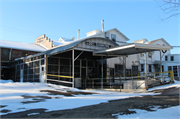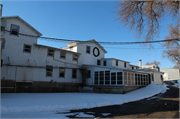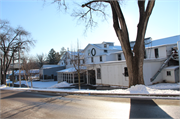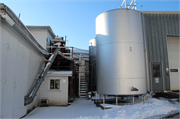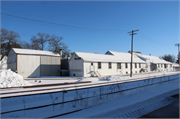| Additional Information: | A 'site file' exists for this property. It contains additional information such as correspondence, newspaper clippings, or historical information. It is a public record and may be viewed in person at the Wisconsin Historical Society, State Historic Preservation Office.
1999: The Lodi Canning Company complex consists of two historic buildings located at the corner of Canning Street and STH 60 that are associated directly with the history of the Lodi Canning Company, and a third historic building located across the railroad tracks at 307 Nestles Ave. that is also now a part of the complex.
The Lodi Canning Co. was founded in 1917 and was then and is still now the largest seasonal employer in Lodi. The first building was the wooden Astylistic Utilitarian form one (76-07-08), built in 1917, to which was later added a tile construction warehouse addition (76-05-06) and a separate weighing station/office building.building (76-04).
These buildings are still very much in use today and are externally in highly original condition.
2020: The Lodi Canning Company complex consists of a 1917 canning plant (AHI No. 111233), c.1925 warehouse (AHI No. 111543), and c.1925 office building (AHI No. 111542). They are located at the intersection of Water Street/STH 60 and Canning Street, just east of a railroad siding of the historic CNW Railroad.
The 1917 canning plant (AHI No. 111233) is a two-and-one-half-story industrial building that has clapboard siding and stands on a concrete foundation. The irregular roof, which features shed-roof dormers and monitor projections along ridges, is covered in a mixture of asphalt shingles and metal; eave overhangs display wooden soffits with brackets. Windows consist of mostly one-over-one, double-hung, replacement sash, though some original multi-pane examples are present. The original portion of the building was completed in 1917 and has several additions, some of which are clad in corrugated metal, including a number of screened rooms along the east and north elevations. A barrel-roof awning leading to a screened vestibule along the east elevation serves as the main entrance to this building as well as the attached c.1920 warehouse to the southwest.
The c.1925 warehouse (AHI No. 111543) is attached to the side (south) elevation of the canning plant and displays a stepped parapet where the two structures meet. The warehouse is a two-story industrial building clad in clay tile and resting on a concrete foundation. Its front-gable roof is covered in corrugated metal and it features a mix of original multi-light and replacement fixed and double-hung windows with concrete sashes and sills along the front (south) facade. A central entrance is located on the south elevation, which also displays a portion of infilled concrete at the southeast corner of the building.
The c.1925 office building (AHI No. 111542) is a one-and-one-half-story cube that is clad in clay tile and rests on a concrete foundation. The hip roof is covered in asphalt shingles with a central brick chimney and wide eave overhang with wood fascia; it also features hip-roof dormers with clapboard siding and paired, one-over-one, double-hung windows on the front (south) facade and side (east and west) elevations. Additional windows are one-over-one, double-hung sash. The office building also has restrooms with exterior entrances.
The Lodi Canning Company incorporated in 1917 with an initial investment of $100,000 from local stockholders and construction of the canning plant, which was completed in 1918. Dr. T.O. Goeres, formerly a dentist in Lodi, became the first president and served in the role for 54 years. The company processed crops from local farms, beginning with corn and beets. Peas were added in 1922 and beet production stopped in 1935. The canning complex expanded by the 1930s, by which time an office and tile warehouse were added, and in 1950 the company purchased the Nestles Milk Plant to the west for additional space. During World War II the Lodi Canning Company employed German prisoners of war who lived at the local fairgrounds. Today the company’s main products remain peas and creamed corn, and it is the only privately owned, single-plant cannery remaining in the state.
2021: The canning plant is a two-and-one-half-story industrial building that was constructed in 1917 as the Lodi Canning Company. The building has clapboard siding and rests on a concrete foundation. The irregular roof, which features shed-roof dormers and monitor projections along ridges, is covered in a mixture of asphalt shingles and metal. Eave overhangs display wooden soffits with brackets.
The east elevation of the building features a c.1960 prefabricated barrel-arch building that has been modified to include partial screened walls serves as the main entrance to canning plant and the attached c.1925 warehouse. A sign reading “Lodi Canning Co.” is located in the gable end. Peas arrive to the factory already shucked and are dumped into a pea hopper, located just east of the barrel-arch building, and cleaned. The pea hopper is surrounded by a metal fence and covered by a flat corrugated metal roof.
The north end of the elevation features a c.1930 screened porch that serves as a locker room as well as several full-height double-leaf beadboard doors; two sugar tanks are also located between the 1917 canning plant and a c.1960 outbuilding at the northeast corner of the canning plant. Windows on the east elevation mostly consist of one-over-one, double-hung, replacement sash; some original multi-pane wood windows are still present.
The north elevation features a pair of double-leaf panel doors. The lot along Canning Street slopes to the southeast, allowing for a partially exposed basement with three-over-three windows on the west elevation; basement windows on the northern side of the west elevation are covered by clapboard panels. Windows on the west elevation consists of original wood six-over-six and nine-over-nine hung sash.
The interior of the building was toured during a site visit. Fixtures appeared to be largely original and intact including exposed wood siding and wood rafters. Although some room functions have likely changed over time, the interior layout appears to remain similar to the period of significance with large, open rooms for equipment.
The canning plant and attached c.1925 warehouse serve as the food processing, cleaning, sorting, canning, and cooking area. |
|---|
| Bibliographic References: | City of Lodi Tax Rolls.
Lodi Enterprise: 11/03/1916, p. 1; 4/06/1917, p. 1; 10/05/1917, p. 1; 10/26/1917, p. 1; 8/16/1918, p. 1; 6/18/1925, p. 1; 7/31/1997, p. 8 (photos).
Lodi Historical Album:1848-1973. Lodi: 1973, pp. 74-75 (historic photos), 120.
Lodi Sesquecentennial, 1848-1998: A Generational Legacy. Lodi: 1998, Inside front cover, pp. 1, 25.
Sanborn-Perris Fire Insurace Maps of Lodi, WI. New York: 1904, 1919, 1930. |
|---|

